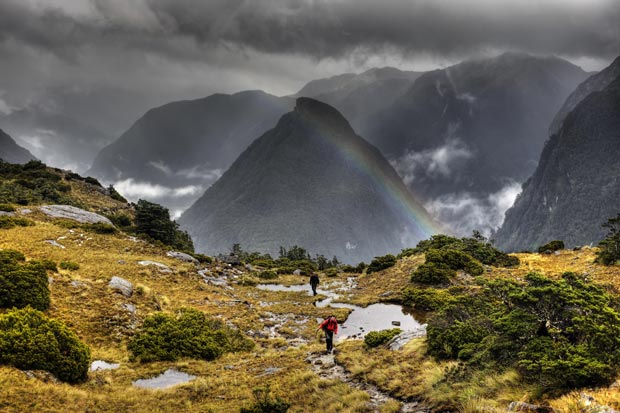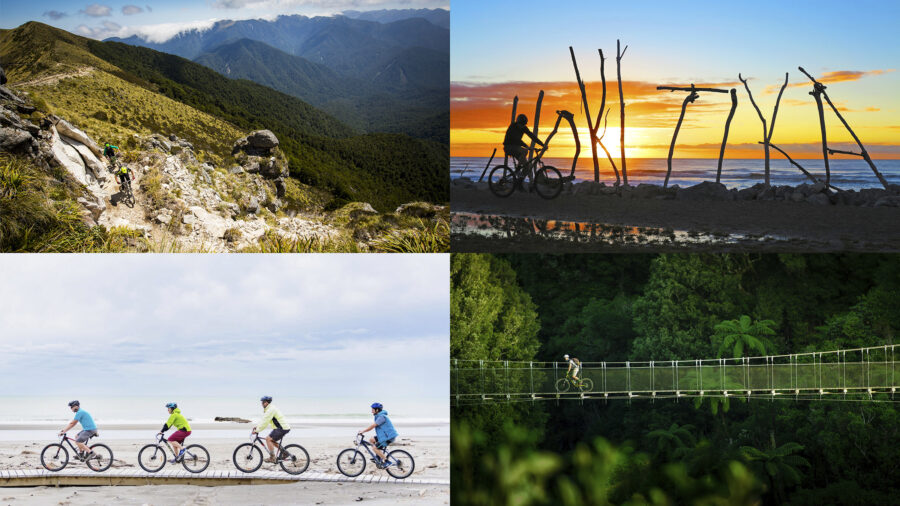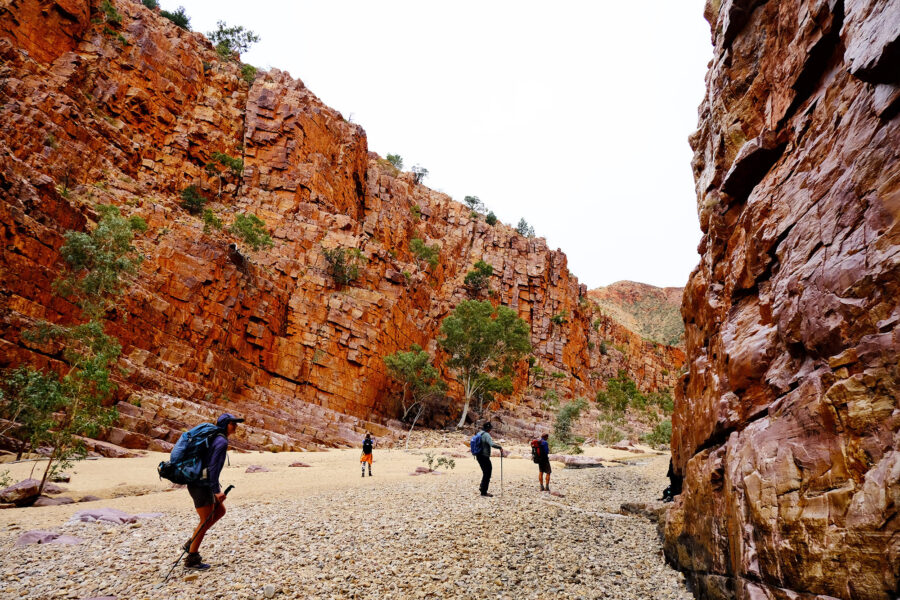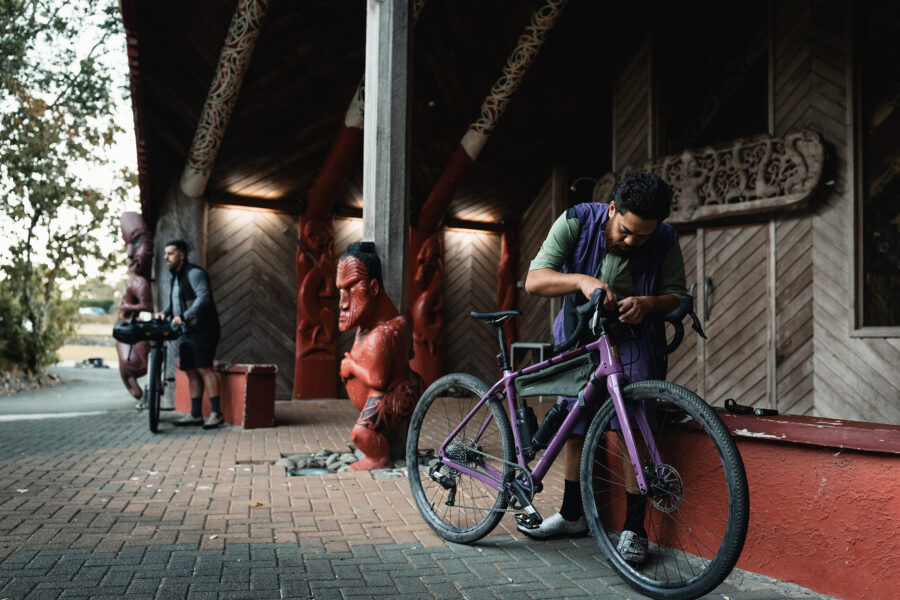Trekking the Dusky Track, New Zealand

ONLY A FEW HUNDRED METRES from the track head and I’ve already taken a dive into the thick sludge beneath my feet. It’s a sobering reminder that Mother Nature is numero uno out here. I pick myself up and view my surroundings. I’m encircled by dense forest – silver beech dominates the landscape, with a lush sub-canopy of pepper tree, broadleaf, coprosmas, fuchsia and soft ferns. The track is a labyrinth of roots, fallen trees and rotten logs with a carpet of vibrant moss covering the ground as far as the eye can see. I feel as though I’ve been thrust back into the Mesozoic era.
I’m on New Zealand’s Dusky Track, one of the country’s longest and most isolated ones. Nestled deep in the heart of the rugged Fiordland National Park, it’s no wonder more people are ditching the traditional walks of Milford and venturing out on this eight to 10-day epic. Established in 1952, Fiordland NP covers a whopping 1.2 million hectares of isolated wilderness, boasting unique environments of mountain, rainforest, lake and fiord coupled with a diverse range of flora and fauna found nowhere else on earth. This can be attributed to the Fiordland’s isolation, limited human activity and turbulent weather patterns where rainfall is measured in metres. It is the largest of NZ’s 14 national parks, lying at the core of South Island’s Te Wahipounamu (Maori for the place of greenstone) World Heritage Area.
The Dusky Track is a challenging 84km tramp linking Lake Hauroko and Lake Manapouri, with an option of a two-day detour to Supper Cove in Dusky Sound. Traversing three valley systems and crossing two mountain ranges, the Dusky’s drawcard of being accessible only by air or sea guarantees a true New Zealand backcountry experience without crowds. The track can be walked from the north or south. From the north, a boat operates daily from Manapouri, 20km south of Te Anau, to West Arm. From the south, you need to charter a boat across Lake Hauroko, 64km west of Tuatapere, to the Hauroko Burn Hut.
I’m joined by two friends on this backcountry pilgrimage, Brian from Massachusetts, USA, and Adam from Sydney. We will be walking the Dusky from the south and after a 45-minute boat ride across New Zealand’s deepest lake – Hauroko, at a depth of 462m – we arrive at the trailhead.
HAUROKO BURN HUT TO LOCH MAREE (THREE DAYS)
Having left the boat and civilisation behind us, it’s a gruelling six-hour walk from Hauroko Burn Hut to our first overnight post, the Halfway Hut. The rains have come and we’ve thrown on our wet weather gear. The Dusky’s reputation as a land of extremes, dominated by the fiercest elements of nature, is well deserved. Initially it’s slow going. Nothing can prepare you for working through knee-deep mud. Screaming thigh and calf muscles have little time to recover as you scramble from one mud pit to another.
Orange track markers are easily distinguishable against the immensity of green that dominates the landscape, making it easy to navigate through the ocean of trees. Following Hauroko Burn we encounter the first of 21 three-wire bridges on the Dusky. With such a staggering number of wire bridges you’ll be forgiven for thinking you’re Philippe Petit, the French high-wire artist who gained fame for his walk between the towers of New York’s World Trade Center in 1974.
In diminishing light and unrelenting rain, we reach Halfway Hut. The Department of Conservation (DOC) huts are quite simply brilliant! They vary in luxury but all are welcome, particularly when you’re tired, wet and smelling like a dead racoon – setting up a tent is the furthest thing from your mind! A hut ticket will set you back NZ$5.10 (A$3.90) and can be purchased prior to your trip at a DOC office. You won’t find a shower or a bidet among the facilities on the Dusky – standard backcountry huts offer a mattress, a fireplace and a pit toilet, but under the circumstances and location it’s the goddamn Hilton! Yes, the huts are amazing but the best thing about them is that you don’t need to carry a heavy tent or sleeping mat which, after eight days of walking, can feel like you’re carrying a bag of cement.
It’s 6am and the deathly silence of Halfway Hut is shattered when Brian’s primus stove roars to life – its defining call sounds like a squadron of Spitfires. Today we are headed for Lake Roe Hut (900m). As we climb above the tree line the forest is transformed from a verdant oasis into a winter wonderland. Silver beech and soft fern trees are replaced by tussock grass. Snow blankets our path to the hut, which sits silently in the distance waiting to be woken from its deep slumber. As the weather closes in around us, the snow whips into a frenzy – it’s in my hair, my ears, it covers my beard; even my eyelashes have snow on them. I can’t escape it!
Awakened next day by the call of Mother Nature, I peer outside the frosty window. Golden icicles line the eaves like rows of jagged diamonds. The sun is out – momentarily – for our walk across the Pleasant Range, which will be the spectacular highlight of the Dusky Track. Overnight snow makes the climb to Lake Horizon slow going. We zig-zag our way up the windswept face, grabbing hold of buried tussock grass for dear life. We take in the breathtaking views of Lake Ursula and Lake Horizon (1050m), watching anxiously as ominous clouds roll in. Brian gets us on the move and we’re heading over the open tops of the Pleasant Range (1100m).
The range is a perfect armchair as we’re gifted with breathtaking views of the Kilcoy and Dingwall mountains to the north and Dusky Sound to the south. It also provides a beautiful backdrop for lunch, so out comes the salami, cheese and rice crackers. Leaving the chilly open tops behind us, the descent is arduous. Below the tree line the track drops steeply with one section almost a six-metre vertical drop supported by a metal chain screwed to the rock wall. This is the only “human introduced” relief during the climb down to Loch Maree Hut.
Roots act as makeshift rope as we slide down boulders and fallen trees, careful not to lose our grip or misplace a step that could result in an undignified face-plant into the forest floor.
We stumble into Loch Maree Hut and are faced with an unexpected scene. A couple of hunters are cooking up fresh venison steaks. Introduced by the first settlers in the mid-19th century and without natural predators, game animal numbers have increased, rapidly threatening the park’s natural environment and giving hunters a vital role to play in managing Fiordland’s environmental sustainability. Introductions complete, we’re offered a slab of venison for dinner.
“You bloody ripper,” I think. It’s a welcome change from the lentils and cracked wheat we’ve been surviving on. Invigorated from a belly full of meat, we kick back and dry out for the night, sharing stories with a couple of Kiwi old boys.
SUPPER COVE (TWO DAYS)
It’s 2am. Torrential rain pummels the hut and the tin roof is booming, making sleep hard to come by. Fiordland is notorious for its weather; strong westerly winds drive moisture-rich air from the Tasman Sea over the mountains, creating heavy rain. With an annual rainfall of 3568mm and 227 rain days at West Arm, according to the National Institute of Water and Atmospheric Research, you’d feel more at home with flippers and a snorkel than hiking boots. Fiordland is one of the wettest places on Earth.
Bleary-eyed, we head this day for the aptly named Supper Cove in Dusky Sound, where blue cod and groper can be caught in abundance. In 1903 west coast miners began the difficult task of building a track linking Supper Cove and Lake Manapouri, which was never completed – workers’ tools are still evident today where they came to an abrupt halt above Loch Maree. More than 100 years later, our group starts the day with a steady climb around the loch before descending parallel with the Seaforth River, where the native grey duck and the rare blue duck (whio) can be seen, and trout fishing is possible. Slowed by swollen backwaters, we use logs as crude bridges, treading their narrow trunks like tightrope walkers.
As we pierce the shroud of forest, the track opens up into Dusky Sound. Stretching 40km long and 8km at its widest point, Dusky Sound is one of New Zealand’s most beautiful and largest fiords, with Long and Cooper islands standing apart. We decide to wade across the Sound, which is at low tide for the most part. Less than 24 hours ago our group was navigating our way over snow-covered peaks and now we find ourselves wading at low tide across Dusky Sound. Talk about a diverse environment!
Crossing the Sound with sandflies in hot pursuit, Adam becomes the first victim to a submerged log, taking a plunge into the icy water. Arms flailing, he rises from the murky depths resembling the creature from the Black Lagoon.
We reach Supper Cove Hut, grabbing hand reels from inside the hut and venturing down to the water’s edge to catch our dinner and overlook the sound. First sighted by Captain James Cook in 1770, Dusky Sound was named Dusky Bay in the diminishing light and he did not enter it. On his return in 1773 Cook used the Sound as a harbour and then spent several weeks exploring the region, meeting several Maori families that lived around the area. If you’re lucky to spot the marine life you’ll see the occasional whale, dolphins and seals. Seal numbers have increased since a ban was placed on the hunting that had begun as early as the 18th century.
LOCH MAREE TO MANAPOURI (THREE DAYS)
We’re en route to Manapouri. Yesterday’s deluge was quickly forgotten and for the first time on the trip our wet weather gear is stowed safely inside our packs. Our first challenge is Deadwood Flats. North of Loch Maree Hut, this low-lying section of track runs close to the Seaforth River and is regarded as one of the toughest along the Dusky when affected by wet conditions.
The Dusky doesn’t disappoint and that’s exactly what we get: a quagmire, the scene ripped straight from a surrealist’s head. Stepping into it, we plummet waist-deep, arms and legs working overtime, battling to escape its merciless grasp. Fatigued and with mud-splattered legs, we take refuge on the banks of the Seaforth.
Over dinner we agree that tomorrow will be our final day on the Dusky Track, cutting the remaining 19km from two days to one. It’s the final chapter in what’s been a remarkable journey. The weather has closed in around us; heavy rains and howling winds.
On our final day, we follow the Kintail Stream north towards our final ascent. As we climb Centre Pass (1100m), my mind starts to wander. I’m thinking about my reintroduction to civilisation; cold beer, hot showers and chocolate, right down to the tiniest detail, trying to block out the sheer pain and exhaustion my body is suffering. Top-side we are treated to the breathtaking views of Tripod Hill and the surrounding valleys. Carved by deep glaciers during the ice ages, these stunning U-shaped valleys were formed from abrasion of the surrounding bedrock some 14,000 years ago.
Passing over the saddle, we are dwarfed by Mount Bain and Mount Memphis. Waterfalls cascade from their sides. The valley below us teems with tussock grass, rocky outcrops, crystal outlets and enchanted forests. It’s the New Zealand of our imagination. Following the Warren Burn north, we pass Upper Spey Hut, stopping only for a moment, eager to maintain our progress. It’s a race against time.
We’re still a couple of klicks from the trackhead and I can barely see my own hand in front of my face, making it extremely difficult to maintain a speedy pace. We finally reach the end with our head torches ablaze in the pitch black, a strangely fitting way to finish this mammoth trip. Savouring the moment we celebrate by devouring the remaining cheese, salami and mountain bread before being tempted to take the essential post-Dusky photographs.
As the sun breaks the horizon over Lake Manapouri, we board the ferry at West Arm and begin cruising back to civilisation; back to a hot breakfast and coffee, back to a shower! It’s a 30-minute ride across this beautiful, tranquil lake and yet the scene is dramatic, which sums up the entire trip for me. Ahead, Manapouri town is inviting, beautiful and sunny with a few scattered clouds, but when I look back to our origin, the contrast is incredible.
The sky is a mash of heavy black clouds that stick to the landscape; it looks as though you’re at the gates of hell. But strangely you feel drawn to the place, drawn to the snow-covered peaks, vast fiords and untamed forests that are the three extraordinary faces of the Dusky Track. For sheer variety of conditions, it is without rival anywhere on earth, a place that will be forever etched in my memory after having ringside seats to this theatrical, ever-changing and unique living landscape with its unfolding drama of life.
Getting there:
Air New Zealand, Qantas, Jetstar, and Virgin Blue service flights to Queenstown from major cities in Australia. From there, Air Fiordland (www.airfiordland.com) offers charter plane services to the track heads. Alternatively, you can take a boat to the start of the track from Tuatapere at the north end (www.duskytrack.co.nz) or Manapouri at the south end.
Reserving a hut:
Camping is not recommended along the track, but huts are available for NZ$5.10 ($3.90) each night. You can purchase passes from a Department of Conservation office.
When to go:
While weather on the Dusky Track is wildly unpredictable year round, summer is the best time to go. Snow, ice and avalanches can make the track impassable in winter. Even in summer, allow a few extra days because the track is often blocked by flooding.
RELATED STORIES





